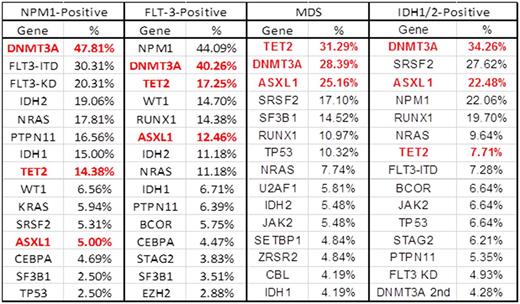Abstract
Introduction: Clonal hematopoiesis, as determined by the presence of TET2, ASXL1, and DNMT3 mutation, is believed to be increasingly common in normal individuals as they age. This phenomenon is currently referred to as clonal hematopoiesis of indeterminate potential (CHIP). It has been reported that a few of these patients will develop myeloid neoplasms that begin as MDS and may evolve into AML. However, the clinical relevance of this particular subset of gene mutations (TET2, ASXL1, and DNMT3A) in healthy individuals is unclear as there are more than 50 genes that have been reported to be involved in myeloid neoplasms.
FLT3 and NPM1 mutations have been reported in de novo AML patients and may occur as a secondary mutations on an MDS background. In order to clarify the significance of TET2, ASXL1, and DNMT3 in CHIP and their relationship to MDS and AML, we assessed the prevalence of TET2, ASXL1, and DNMT3 genes in patients with NPM1 and FLT3 mutations. In addition, since IDH1/2 gene are rarely mutated with TET2, we also studied the frequency of mutations of various myeloid genes in this group of patients.
Methods: A total of 6390 consecutive bone marrow aspirate samples or peripheral blood samples submitted with clinical impression of AML, MDS, or MPN between January 2014 and mid 2017 were tested for mutations in myeloid genes using NGS. We used the TruSight Myeloid Panel (Illumina, San Diego, CA) for detecting missense mutations and fragment length analysis (FLA) for detecting ITD in FLT3 and large indels in CALR . DNA was extracted from samples using the QIAamp DNA Mini Kit. This NGS testing covers mutations in 54 myeloid-related genes. The average depth of sequencing was 10,000x.
Results: In our database of consecutively tested patients, there were 311 patients with FLT3 mutations, 318 patients with NPM1 mutation, and 467 patients with IDH1/2 mutation. In addition, there were 308 patients diagnosed as MDS. All these patients tested for mutations in all 54 myeloid-related genes. The median age of patients in FLT3, MDS, IDH1/2, and NPM1 groups was 65, 75, 69, and 66, respectively. The top 4 most frequently mutated in genes in the FLT3 -positive patients, which present AML, were NPM1, DNMT3, WT1, and RUNX1 . In patients with NPM1 mutations, also representing AML, the top 4 most mutated genes were FLT3, IDH2, NRAS, and PTPN11 . In the IDH1/2 mutated patients, the top 4 mutated genes were DNMT3A, SRSF2, ASXL1, and NPM1 . As expected in the MDS group, the top 4 mutated genes were TET2, DNMT3A, ASXL1, and SRSF2 .
Conclusions: The demonstration that mutations in TET2, DNMT3A, and ASXL1 are most common in patients presenting with MDS, as well as in CHIP, but not in patients presenting with acute myeloid neoplasms, suggests that CHIP likely represents early MDS. It is possible that mutations in these genes in few hematopoietic cells may not be adequate for manifestation of clinical MDS, but the presence of these mutations in large number of cells (high VAF) or the accumulation of mutations in additional genes is necessary for clinical disease. Therefore the clinical relevance of CHIP should always be considered in conjunction with other mutations and with VAF.
Ma: NeoGenomics: Employment. De Dios: NeoGenomics: Employment. Funari: NeoGenomics: Employment. Sudarsanam: NeoGenomics: Employment. Jiang: NeoGenomics: Employment. Agersborg: NeoGenomics: Employment. Hummel: NeoGenomics: Employment. Blocker: NeoGenomics: Employment. Albitar: NeoGenomics: Employment.
Author notes
Asterisk with author names denotes non-ASH members.


This feature is available to Subscribers Only
Sign In or Create an Account Close Modal